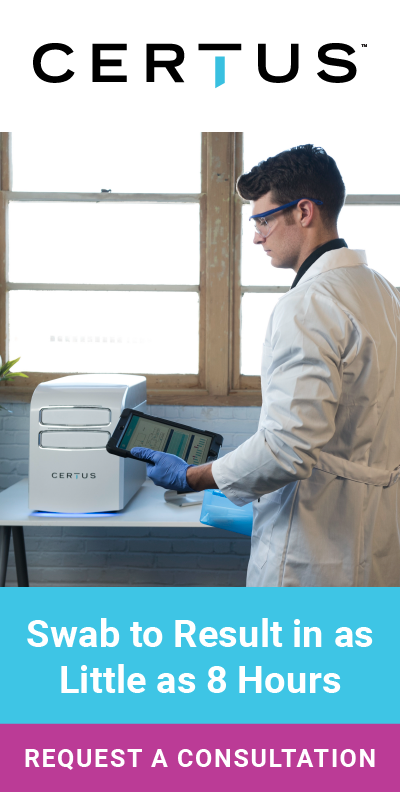Editor’s note: This is part of a series on food safety costs for businesses. The series is sponsored by CERTUS Food Safety. This piece explores considerations when choosing a pathogen testing program.
It’s pretty simple – food compromises are bad for business, says Chief Scientific Officer Douglas Marshall, Ph.D., CFS for Eurofins Microbiology Laboratories Inc.
“If a food brand is splashed in the news for a recall or an outbreak, not only is it going to affect that particular brand or that particular product produced, but it’s going to affect everything else that’s attached to that brand,” states Marshall. There’s the cost of the recall, lawyers and potential criminal financial liabilities – not to mention civil lawsuits from the victims.”
There are significant financial ramifications for missing the mark when it comes to the integrity of food released to the market – making pathogen testing a linchpin in the overall success of a business.
However, the not so simple part of this cost of doing business is figuring out a pathogen testing strategy that best suits environmental monitoring program needs and any required customer or government standards – while still allowing the company to turn a profit.
Third party laboratories and in-house laboratories based in a central location to serve a company’s multiple manufacturing sites are industry standard, says Marshall. As technology advances, in-house pathogen testing kits are also making their way to market.
 KISS your woes away
KISS your woes away
There’s a whole laundry list of considerations that make one method of pathogen testing more suitable for a company than another, says Marshall. Because of this, he advises to follow the KISS (Keep It Simple, Stupid) when making decisions, prioritising the following aspects:
- Proven efficacy by independent, third party organisations like AOAC, AFNOR and MicroVal
- Accepted method of testing by customers
- Feasible for personnel
- Cost effective
Determining if a test is accepted by customers and has proven efficacy is straightforward. However, the most challenging comparison to make is when it comes to costings and personnel requirements, he adds.
“At the end of the day, you’re in the business of manufacturing food – not running laboratories. This requires a high-tech, special skillset that comes with the overhead costs of the physical lab itself, but also the warm bodies with a scientific background to actually execute the tests,” he says. “Those people aren’t cheap, and they don’t grow on trees. They can also cause bigger business management issues in the event of unavoidable things like employee turnover, vacation time or sick leave. This is why it is important to make sure analyses are done correctly. Then at the end of the day, their conclusion is something that’s right for their operation as a whole for long-term success.”
Mix and match
According to Marshall, there is no pathogen testing silver bullet that gives a cut and dry solution to all the needs of a company. However, there is a lot to be gained when utilising a combination of different methods.
“One thing company’s often fail to recognize is you really need to be running a positive control, which necessitates you have some sort of a laboratory environment. Without that, you have no data that says your test is actually working,” he says. “You need to do verification every day to ensure the method is delivering an accurate data point every day. You also need to be doing validation, which is usually once a year, once quarter or once a month depending on your budget and your risk profile. Third party labs are a good verification resource for in-house testing.”
Third-party labs are also beneficial for companies performing testing in-house when certain accreditations are needed.
“For example, ISO 17025 accreditation. The vast majority of third-party labs hold that accreditation and they have very robust quality systems to be able to earn it and maintain it. Those running small in-house laboratories planning to bring their operations up to that level may find the process financially not do-able, so they’re really running their testing environment in a way that may not be very robust,” he explains. “Others will outsource to meet customer expectations. Perhaps their system doesn’t have the level of sensitivity required.”
Integrating in-house pathogen testing kits also have their uses for companies needing to make quick business management decisions, adds Marshall.
“One of the main advantages of doing in-house testing is reducing turnaround time to achieve an actionable data point, especially for perishable product. The longer it is sitting in a warehouse or sitting in a truck waiting for laboratory results, the more you’re cutting into the shelf life of the product. If the data can get there quicker, then that allows that company to reduce their cost of warehousing and shelving,” he says.
Is it better, faster and cheaper?
When assessing a current pathogen testing system and analysing potential new technologies, Marshall encourages food companies to answer the following before deciding:
Is it better?
Is it faster?
Is it cheaper?
“These are the three things to always look for – and explore every aspect of. For example, is it better? This could mean a number of things, such as: easier to use, less floor-space, less waste, fewer technician hours, or more sensitive – all of those could be better. All of those things could be all on the “better” category,” he concludes. “Make sure every component is taken into consideration, because there are serious financial problems for getting it wrong.”
(To sign up for a free subscription to Food Safety News, click here.)

